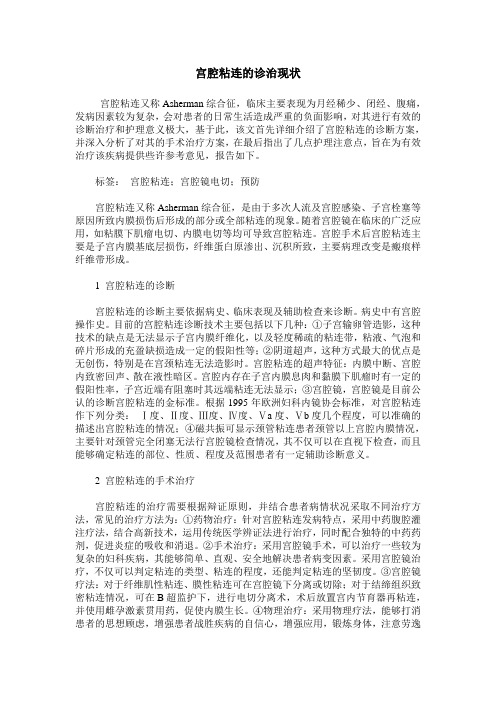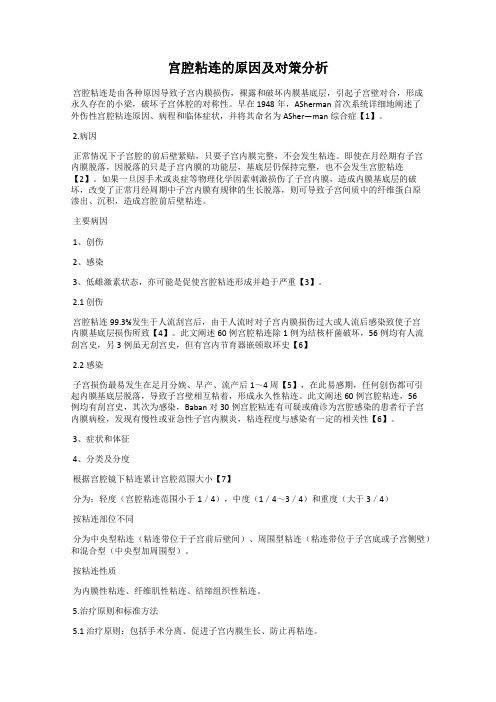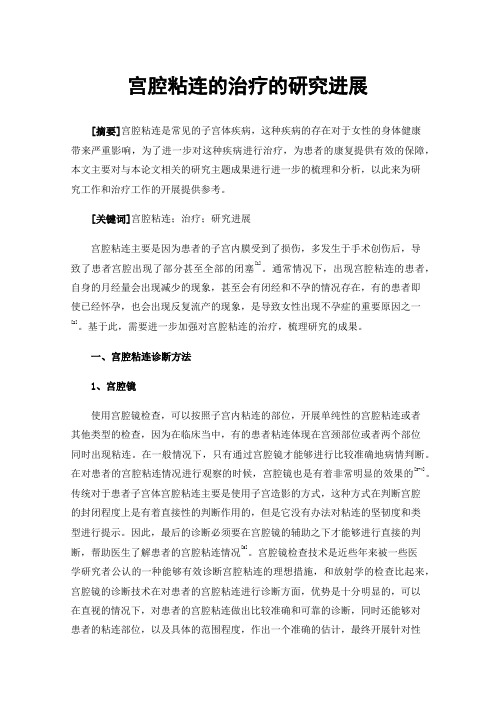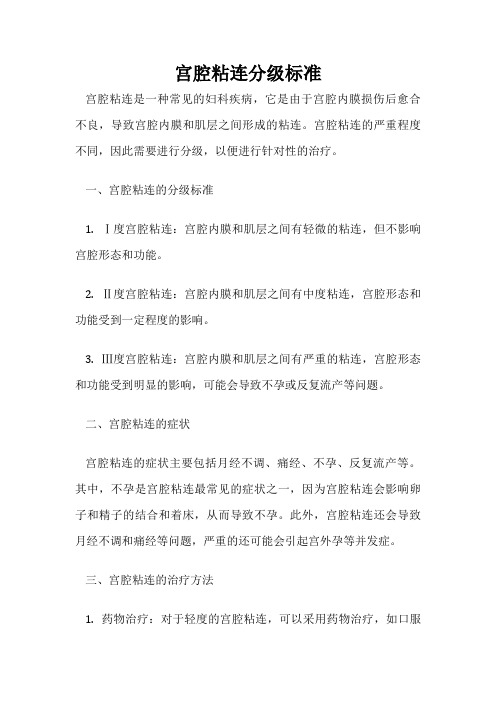不同程度宫腔粘连的治疗方法及预后差异
宫腔粘连

临床表现
临床上主要表现为月经过少或闭经、周期性 下腹痛、不孕或习惯性流产及胎盘粘连。
(中国内镜学杂志,2008,14 ( 11) : 113)
概述
IUA的发病率尚不明确。可能与病人及部分医 生对IUA缺乏认知, 部分宫腔粘连也可以完 全不表现临床症状, 不引起病人重视; 确诊 IUA需要特殊手段; 非婚人流术后难于随访; 存在地域及民族的差异性等方面因素有关。
MARCH分类
轻 <1/4 粘连菲薄或纤细 输卵管开口及 宫腔上端病变轻或清晰可见 中 1/4-3/4 仅粘连形成,无宫壁粘连,开口 和宫Байду номын сангаас上部闭锁 重 >3/4 宫壁粘连或粘连带肥厚 开口及宫 腔上端闭锁
ESGE分类
I 纤维样粘连带 宫角及开口正常 II 宫腔前后壁致密,纤维素样粘连 III 纤维样粘连致部分宫腔及一侧宫角闭锁 IV纤维样粘连致部分宫腔及二侧宫角闭锁 Va 粘连带瘢痕化致宫腔极度变形及狭窄 Vb粘连带瘢痕化致宫腔消失
病因与发病机制
3.女性继发生殖器结核是引起IUA显著高发因 素。其所导致的IUA往往是严重性粘连,整 个宫腔闭锁,内膜破坏,临床表现为闭经, 预后较差。 4.子宫先天畸形。 5.遗传因素。 目前IUA形成的发病机制尚存争议。
宫腔粘连的诊断
IUA 的诊断包括临床表现和辅助检查, 如 B 超和 HSG,诊断的金标准为宫腔镜检查直 视下对粘连的诊断和分类。
病因与发病机制
任何造成子宫内膜基底层受损的因素均可导致 IUA。常见原因如下: 1.IUA主要与宫腔操作有关。妊娠是IUA最重要的诱 发因素,人工流产时不规范的宫腔手术操作是其 引起IUA的主要原因。 2.宫内感染是否导致IUA仍存在很多争议,没有研究 证明感染与IUA存在直接关系,但其可促使IUA 进一步发展已基本得到学者的共识。
《宫腔粘连的防治》课件

04
宫腔粘连的治疗方法
宫腔粘连的治疗手段
药物治疗
通过口服或注射药物,缓解宫腔粘连 引起的疼痛和不适,促进子宫内膜修 复。
手术治疗
对于严重的宫腔粘连,可能需要手术 治疗,包括宫腔镜手术和开腹手术等 。
物理治疗
如微波、超声等物理治疗方法,可以 促进子宫内膜的血液循环,缓解粘连 。
宫腔粘连的预防
针对不同原因引起的宫腔粘连,采取 相应的预防措施,如控制炎症、减少 宫腔操作等。
宫腔镜检查
宫腔镜检查是诊断宫腔粘连的 金标准,可以直接观察到宫腔
内的情况。
子宫输卵管造影
通过子宫输卵管造影可以了解 输卵管通畅情况,间接判断宫
腔粘连的程度。
组织病理学检查
对于可疑的病变组织,需要进 行组织病理学检查以明确诊断
。
宫腔粘连的诊断标准
01
02
03
轻度粘连
粘连范围小于宫腔面积的 1/3,输卵管开口正常或 部分闭锁。
避免不必要的宫腔操作
如刮宫、人流等,尽量减少对子宫内膜的损 伤。
科学避孕
选择合适的避孕方法,避免频繁使用紧急避 孕药或进行不成功的试管婴儿程序。
预防宫腔粘连的注意事项
提高自我保护意识
了解宫腔粘连的危害,增强预 防意识,积极采取措施。
定期进行妇科检查
及时发现并治疗可能导致宫腔 粘连的疾病,如子宫内膜炎、 宫颈炎等。
中度粘连
粘连范围占宫腔面积的 1/3-2/3,输卵管开口闭 锁,但通过锐器可分离。
重度粘连
粘连范围大于宫腔面积的 2/3,输卵管开口闭锁且 无法分离。
03
宫腔粘连的预防措施
预防宫腔粘连的方法
保持生殖系统卫生
定期清洗外阴,避免不洁性行为,减少感染 和炎症的风险。
宫腔粘连的诊治现状

宫腔粘连的诊治现状宫腔粘连又称Asherman综合征,临床主要表现为月经稀少、闭经、腹痛,发病因素较为复杂,会对患者的日常生活造成严重的负面影响,对其进行有效的诊断治疗和护理意义极大,基于此,该文首先详细介绍了宫腔粘连的诊断方案,并深入分析了对其的手术治疗方案,在最后指出了几点护理注意点,旨在为有效治疗该疾病提供些许参考意见,报告如下。
标签:宫腔粘连;宫腔镜电切;预防宫腔粘连又称Asherman综合征,是由于多次人流及宫腔感染、子宫栓塞等原因所致内膜损伤后形成的部分或全部粘连的现象。
随着宫腔镜在临床的广泛应用,如粘膜下肌瘤电切、内膜电切等均可导致宫腔粘连。
宫腔手术后宫腔粘连主要是子宫内膜基底层损伤,纤维蛋白原渗出、沉积所致,主要病理改变是瘢痕样纤维带形成。
1 宫腔粘连的诊断宫腔粘连的诊断主要依据病史、临床表现及辅助检查来诊断。
病史中有宫腔操作史。
目前的宫腔粘连诊断技术主要包括以下几种:①子宫输卵管造影,这种技术的缺点是无法显示子宫内膜纤维化,以及轻度稀疏的粘连带,粘液、气泡和碎片形成的充盈缺损造成一定的假阳性等;②阴道超声,这种方式最大的优点是无创伤,特别是在宫颈粘连无法造影时。
宫腔粘连的超声特征:内膜中断、宫腔内致密回声、散在液性暗区。
宫腔内存在子宫内膜息肉和黏膜下肌瘤时有一定的假阳性率,子宫近端有阻塞时其远端粘连无法显示;③宫腔镜,宫腔镜是目前公认的诊断宫腔粘连的金标准。
根据1995年欧洲妇科内镜协会标准,对宫腔粘连作下列分类:Ⅰ度、Ⅱ度、Ⅲ度、Ⅳ度、Ⅴa度、Ⅴb度几个程度,可以准确的描述出宫腔粘连的情况;④磁共振可显示颈管粘连患者颈管以上宫腔内膜情况,主要针对颈管完全闭塞无法行宫腔镜检查情况,其不仅可以在直视下检查,而且能够确定粘连的部位、性质、程度及范围患者有一定辅助诊断意义。
2 宫腔粘连的手术治疗宫腔粘连的治疗需要根据辩证原则,并结合患者病情状况采取不同治疗方法,常见的治疗方法为:①药物治疗:针对宫腔粘连发病特点,采用中药腹腔灌注疗法,结合高新技术,运用传统医学辨证法进行治疗,同时配合独特的中药药剂,促进炎症的吸收和消退。
宫腔粘连指南

宫腔粘连指南(总10页)--本页仅作为文档封面,使用时请直接删除即可----内页可以根据需求调整合适字体及大小--宫腔粘连临床诊疗中国专家共识宫腔粘连(intrauterine adhesions, IUA)是妇科常见、对生育功能严重危害并且治疗效果较差的宫腔疾病,严重影响女性生殖生理及身心健康。
继1894 年首次发表 IUA 的文献报道之后,1948 年,Asherman 详细描述了29 例流产产后刮宫所致IUA 病例,并将其定义为“损伤性闭经(traumatical amenorrhea)”,又称为 Asherman 综合征。
目前,IUA在我国的发病率居高不下,并且随着宫腔手术的增加呈逐年增长趋势。
文献报道,多次人工流产、刮宫所致的 IUA 发生率高达 25%~30%[1],已经成为月经量减少、继发不孕的主要原因。
目前,针对重度 IUA 尚无有效恢复生育功能和月经生理的治疗方法;宫腔镜宫腔粘连分离术(transcervical resection of adhesion, TCRA)后再粘连率高达 %[2],妊娠成功率仅 %~%[3-4]。
由于国内对 IUA 研究的资料有限,缺乏大样本量随机对照试验的研究证据,本共识参考 2010 年美国妇科腹腔镜医师协会(American Association of Gynecological Laparoscopists, AAGL)发布的关于IUA 的临床指南[5],结合我国的具体临床实践,参照加拿大预防保健服务专责小组(Canadian Task Force on Preventive Health Care)[6]及美国预防保健工作组(US Preventive Services Task Force)[7]制定的循证医学证据等级,对目前学术界公认的治疗方法进行归纳总结。
随着临床诊疗方法的提高和循证医学证据的完善,本共识也将不断修订更新。
本共识中标出的证据等级及推荐等级如下:(1)证据等级:I:证据至少来自 1 个高质量的随机对照研究或荟萃分析;IIa:证据至少来自 1 个设计严谨的非随机对照研究;IIb:证据至少来自 1 个设计良好的队列研究(前瞻性或回顾性)或病例对照研究,并且是 1 个以上研究中心的数据;IIc:证据至少来自 1 个设计良好的非试验性描述研究,如相关性分析研究、比较性分析研究或病例报告;III:基于专家委员会的报告或权威专家的经验。
子宫内膜粘连怎么治疗

子宫内膜粘连怎么治疗作者:曾朝红来源:《健康必读·下旬刊》2020年第06期【中图分类号】R711.4 【文献标识码】A 【文章编号】1672-3783(2020)06-18--02子宫内膜粘连是一种女性常见的妇科疾病,子宫颈管粘连是指由于宫颈管黏膜受机械损伤后粘连,致使颈管狭窄或闭锁。
子宫腔粘连是指宫腔前后壁部分或全部互相粘连,以致宫腔变窄或消失,会对月经造成影响,甚至不孕,因此要引起足够重视。
如果出现小腹疼痛、月经异常、妊娠异常等表现的症状,应该及时到医院去接受治疗,听从医生的建议,早日治疗,早日恢复健康。
子宫内膜粘连到底应该怎样去治疗呢?想必很多女性朋友都想知道,接下来为大家介绍一下,希望对患者们有所帮助。
症状一是周期性腹痛。
在流产或者刮宫后的一个月时间左右,不明原因的出现下腹部疼痛的情况。
如果患者的情况比较严重,会引发更多的问题,例如坐卧不安、行动困难、排便痛苦等。
疼痛感会持续大概一个星期左右,之后便会慢慢的消失,一个月之后又会出现,具有明显周期性特点。
而且随着时间推移,疼痛感会不断增加。
二是月经的改变,女性月经量减少或者经期时间延长,甚至闭经等,具体情况要根据子宫内膜粘连的程度来看。
如果病情比较轻,那对正常月经不会产生太大的影响,如果是重度患者,就会有明显经量减少或者闭经的情况。
子宫内膜粘连会使得内膜受损,让子宫容积减小,对女性正常怀孕造成不利影响。
就算是怀孕了,也有可能发生流产或者早产的情况,可见危害性是非常大的。
当出现上述症状的时候要及时到医院去接受治疗,绝对不能拖延,否则会变得更加严重。
部分患者觉得子宫内膜粘连不是什么大病,所以不用太在意,这种认识是错误的。
加深对子宫内膜粘连的认识,如果出现出现小腹疼痛、月经异常、妊娠异常等表现及早去检查治疗,从而尽快恢复身体健康。
病因子宫内膜粘连的原因是非常复杂的,包括人为因素、手术因素、宫腔手术等,比如患者做过子宫肌瘤剜除术、子宫纵膈切除术等,也会引发子宫内膜粘连。
宫腔粘连的治疗进展

2019年4月B 第6卷/第11期Apr. B. 2019 V ol.6, No.1117实用妇科内分泌电子杂志Electronic Journal Of Practical Gynecologic Endocrinology宫腔粘连的治疗进展冯 琴,艾 瑛*(云南省第一人民医院(昆明理工大学附属医院)妇产科,云南 昆明 650032)【关键词】宫腔粘连;治疗进展【中图分类号】R711.74 【文献标识码】A 【文章编号】ISSN.2095-8803.2019.11.17.02宫腔粘连(Intrauterine adhesions ,IUA)是由于感染、人流术等宫腔操作导致子宫内膜损伤,内膜纤维化,子宫壁相互粘连,宫腔容积缩小的一种病理状态。
随着年轻女性人流、药流等宫腔操作增多,以及宫腔镜手术的普及,宫腔粘连患病率有上升的趋势[1-2],已成为妇科常见病之一。
宫腔粘连的治疗包括手术治疗、促进子宫内膜再生治疗、预防再次粘连发生、术后随访及指导受孕。
迄今为止,尚无治疗宫腔粘连的理想方案,轻、中度患者通过以上治疗可达一定疗效,但重度粘连复发率可高达60%[2-5]。
1 IUA的手术治疗宫腔镜下宫腔粘连分离术(Transcervical resection of adhesions ,TCRA )目前已成为宫腔粘连最主要的治疗方法,避免了既往治疗性刮宫的盲目性和不彻底。
TCRA 手术方式主要有机械性宫腔镜手术和能源性宫腔镜手术。
机械性手术是在宫腔镜直视下用分离剪钝性或锐性分离粘连,对子宫内膜损伤较小或者基本无损伤,减少创面渗出,不易形成瘢痕组织,有利于后期子宫内膜的生长,其缺点是止血困难,主要适用于轻度粘连。
能源性手术是在宫腔镜直视下用能源系统如单极电极、双极电极、激光分离宫腔粘连,止血效果好、手术时间短,对中、重度粘连分离效果较好,但其能源或热量对周围正常子宫内膜组织有一定的损伤性,较易形成瘢痕[1,5]。
宫腔黏连手术后防止重粘连方案汇总

参照《中药新药临床研究指导原则》(2002 年版)、《中医妇科学》(10 版)。
肾虚血瘀证:主症:经量明显少于既往,经期不足 2 d,甚或点滴即净,经色紫暗,有血块,甚或月经停闭不行。
次症:经行小腹胀痛,腰膝酸软,头晕耳鸣,失眠健忘,夜尿频多,口干不欲饮等。
舌脉:舌质淡暗或淡红,或有瘀斑、瘀点,脉弦细或沉涩。
具备以上主症及至少 2 项次症,结合舌脉,即可诊断。
阿司匹林具有抑制环氧合酶活性,改善子宫内膜血流灌注,促进子宫内膜修复的作用[7] 。
已有研究提示雌激素口服,阴道上药,经皮给药,对宫腔重度粘连术后预后对术后月经恢复、内膜厚度、宫腔形态、妊娠结局及不良反应情况等无明显影响[8] 左欣,杨慧云,陈芳,等. 两种方法预防宫腔粘连分离术后再粘连疗效分析[J]. 实用妇产科杂志,2015,31(7):540-542. [8] 任春盈,任琛琛,杨立,等. 雌激素给药途径对宫腔重度粘连术预后的影响[J]. 中国妇幼保健,2017,32(20):4947-4950.有研究认为在IUA 术后应用小剂量阿司匹林联合雌激素能有效改善患者宫动脉及子宫内膜的血流灌注,促进子宫内膜增厚和增加子宫内膜 A 型的比例[9] 。
有报道麒麟丸联合芬吗通治疗因子宫内膜薄而致的不孕, 可改善子宫内膜厚及血流, 提高治疗半年后的自然妊娠率[10] 。
林妍等[11]研究发现采用益肾健脾祛瘀方联合雌孕激素联合人工周期治疗,较单一雌孕激素序贯人工周期治疗有较高的临床运用价值,且不良反应少。
四川省第二中医医院妇科观察组:白莲散结汤:莪术15 g, 皂角刺10 g,猪苓20 g,白花蛇舌草30 g,半枝莲30 g,土鳖虫10 g,仙茅15 g ,淫羊藿15 g,分粘术后第2 d 开始口服,每日1 剂,水煎服,连服21 d。
芬吗通片(雌二醇片/ 雌二醇地屈孕酮片, 荷兰雅培公司),用法:红片(含雌二醇2 mg,qd,分粘术后第2 d 开始口服,连续服21 d, 后7 d 服黄片(雌二醇 2 mg,地屈孕酮10 mg)。
宫腔粘连分级评定标准

宫腔粘连分级评定标准
一般情况下,子宫粘连分三级。
有轻度子宫粘连、中度子宫粘连、重度子宫粘连。
1.轻度子宫粘连:轻度的子宫粘连,患者的输卵管开口和宫腔上端部位的病变会比较轻微。
通常宫腔累积面积小于25%,且粘连较薄,容易出现流产的现象,但是一般不会导致不孕。
2.中度子宫粘连:通常中度子宫粘连,宫腔粘连面积达到25-75%,还会导致精子和卵子形成受精卵的概率变小,容易引发不孕、月经不调等症状。
3.重度子宫粘连:通常重度子宫粘连,病变已经累及宫腔组织大于3/4,病情会比较严重,粘连较厚,通常会出现月经量减少、闭经,甚至不孕的现象。
在治疗期间,一定要保持好的心态,不要有太大的心理压力。
同时也要注意饮食清淡,不要吃辛辣、刺激的食物,否则会加重病情。
宫腔粘连的原因及对策分析

宫腔粘连的原因及对策分析宫腔粘连是由各种原因导致子宫内膜损伤,裸露和破坏内膜基底层,引起子宫壁对合,形成永久存在的小梁,破坏子宫体腔的对称性。
早在1948年,ASherman首次系统详细地阐述了外伤性宫腔粘连原因、病程和临体症状,并将其命名为ASher—man综合症【1】。
2.病因正常情况下子宫腔的前后壁紧贴,只要子宫内膜完整,不会发生粘连。
即使在月经期有子宫内膜脱落,因脱落的只是子宫内膜的功能层,基底层仍保持完整,也不会发生宫腔粘连【2】。
如果一旦因手术或炎症等物理化学因素刺激损伤了子宫内膜,造成内膜基底层的破坏,改变了正常月经周期中子宫内膜有规律的生长脱落,则可导致子宫间质中的纤维蛋白原渗出、沉积,造成宫腔前后壁粘连。
主要病因1、创伤2、感染3、低雌激素状态,亦可能是促使宫腔粘连形成并趋于严重【3】。
2.1 创伤宫腔粘连99.3%发生于人流刮宫后,由于人流时对子宫内膜损伤过大或人流后感染致使子宫内膜基底层损伤所致【4】。
此文阐述60例宫腔粘连除1例为结核杆菌破坏,56例均有人流刮宫史,另3例虽无刮宫史,但有宫内节育器嵌顿取环史【6】2.2 感染子宫损伤最易发生在足月分娩、早产、流产后1~4周【5】,在此易感期,任何创伤都可引起内膜基底层脱落,导致子宫壁相互粘着,形成永久性粘连。
此文阐述60例宫腔粘连,56例均有刮宫史,其次为感染,Baban对30例宫腔粘连有可疑或确诊为宫腔感染的患者行子宫内膜病检,发现有慢性或亚急性子宫内膜炎,粘连程度与感染有一定的相关性【6】。
3、症状和体征4、分类及分度根据宫腔镜下粘连累计宫腔范围大小【7】分为:轻度(宫腔粘连范围小于1/4),中度(1/4~3/4)和重度(大于3/4)按粘连部位不同分为中央型粘连(粘连带位于子宫前后壁间)、周围型粘连(粘连带位于子宫底或子宫侧壁)和混合型(中央型加周围型)。
按粘连性质为内膜性粘连、纤维肌性粘连、结缔组织性粘连。
5.治疗原则和标准方法5.1 治疗原则:包括手术分离、促进子宫内膜生长、防止再粘连。
宫腔粘连的治疗的研究进展

宫腔粘连的治疗的研究进展[摘要]宫腔粘连是常见的子宫体疾病,这种疾病的存在对于女性的身体健康带来严重影响,为了进一步对这种疾病进行治疗,为患者的康复提供有效的保障,本文主要对与本论文相关的研究主题成果进行进一步的梳理和分析,以此来为研究工作和治疗工作的开展提供参考。
[关键词]宫腔粘连;治疗;研究进展宫腔粘连主要是因为患者的子宫内膜受到了损伤,多发生于手术创伤后,导致了患者宫腔出现了部分甚至全部的闭塞[1]。
通常情况下,出现宫腔粘连的患者,自身的月经量会出现减少的现象,甚至会有闭经和不孕的情况存在,有的患者即使已经怀孕,也会出现反复流产的现象,是导致女性出现不孕症的重要原因之一[2]。
基于此,需要进一步加强对宫腔粘连的治疗,梳理研究的成果。
一、宫腔粘连诊断方法1、宫腔镜使用宫腔镜检查,可以按照子宫内粘连的部位,开展单纯性的宫腔粘连或者其他类型的检查,因为在临床当中,有的患者粘连体现在宫颈部位或者两个部位同时出现粘连。
在一般情况下,只有通过宫腔镜才能够进行比较准确地病情判断。
在对患者的宫腔粘连情况进行观察的时候,宫腔镜也是有着非常明显的效果的[3-4]。
传统对于患者子宫体宫腔粘连主要是使用子宫造影的方式,这种方式在判断宫腔的封闭程度上是有着直接性的判断作用的,但是它没有办法对粘连的坚韧度和类型进行提示。
因此,最后的诊断必须要在宫腔镜的辅助之下才能够进行直接的判断,帮助医生了解患者的宫腔粘连情况[5]。
宫腔镜检查技术是近些年来被一些医学研究者公认的一种能够有效诊断宫腔粘连的理想措施,和放射学的检查比起来,宫腔镜的诊断技术在对患者的宫腔粘连进行诊断方面,优势是十分明显的,可以在直视的情况下,对患者的宫腔粘连做出比较准确和可靠的诊断,同时还能够对患者的粘连部位,以及具体的范围程度,作出一个准确的估计,最终开展针对性的治疗[6]。
对于门诊的宫腔镜检查来说,既能够用在患者疾病的诊断当中,同时也可以用在治疗之后的随访复查当中。
宫腔粘连临床特点及治疗结局

宫腔粘连临床特点及治疗结局柳鑫;段华【摘要】目的通过对宫腔粘连患者的临床资料收集与分析为宫腔粘连的诊疗与预后评估提供参考.方法回顾性分析有生育要求的153例宫腔粘连患者临床资料.应用SPSS 19.0软件进行统计分析.结果与妊娠相关的刮宫引起的宫腔粘连占88.9%,生殖道感染因素占9.2%,患者术后妊娠率为50.3%.多因素分析表明,年龄小、宫腔粘连程度轻、术后月经改善、宫腔镜二探宫腔无粘连发生是利于宫腔粘连患者妊娠的因素.分娩人群中,剖宫产率为81.6%,早产率4.1%,围生期大出血发生率为10.2%,胎盘异常发生率为12.2%.结论妊娠期子宫宫腔内手术是引起宫腔粘连的主要原因;患者年龄、宫腔粘连期别、术后月经情况、宫腔镜二探宫腔是否粘连是影响患者术后能否妊娠的因素;宫腔粘连患者妊娠时剖宫产率高,并发症发生率高.【期刊名称】《医学研究杂志》【年(卷),期】2014(043)008【总页数】4页(P86-89)【关键词】宫腔粘连;宫腔粘连分离术;妊娠;月经【作者】柳鑫;段华【作者单位】100070 首都医科大学附属北京佑安医院妇幼中心;100006 首都医科大学附属北京妇产医院微创中心【正文语种】中文【中图分类】R711子宫腔粘连性疾病在我国发生率高居世界首位,并且呈逐年增长趋势,据报道大约40%的不孕患者和7%的继发性闭经均有不同程度的宫腔粘连[1]。
目前,针对重度子宫腔粘连性疾病尚没有能够改善生育功能和月经生理的有效治疗,既往有报道标准的宫腔镜宫腔粘连性疾病分离手术后再粘连率高达62.5%,妊娠成功率仅约20%[2]。
对于宫腔粘连疾病的临床特点及影响疗效的因素、治疗后的效果如何尚缺少基于大量病例的报告及系统分析。
本研究通过对宫腔粘连患者的临床资料的全面收集与分析旨在了解宫腔粘连疾病的临床特点及治疗结局以及影响治疗结局的因素,为宫腔粘连的诊疗与预后评估提供参考。
资料与方法1.病例来源:(1)研究对象:调查2005年1月~2011年8月于首都医科大学附属北京妇产医院微创中心因宫腔粘连住院诊治的患者的临床资料。
宫腔粘连的治疗方法有哪些

宫腔粘连的治疗方法有哪些
宫腔粘连是因为子宫内膜过度刮净后,导致子宫内膜不再平滑,产生粘连现象。
治疗方法有以下几种:
1. 再次进行手术,清除或切断粘连,保持子宫内膜的平滑状态,促进血液循环,预防再次形成宫腔粘连。
2. 口服或注射雌激素,补充女性体内雌激素水平,促进子宫内膜的生长和再生。
但是,如果存在卵巢功能低下或全切除的情况,则不适合进行激素替代治疗。
3. 实施人工周期治疗,采用人工方法进行排卵和受精,从而帮助子宫内膜恢复正常状态。
4. 进行物理治疗,如超声和电疗,帮助切除或清除宫腔内的瘢痕组织,并促进宫腔内膜的再生。
5. 采用中成药治疗,如复方丹参口服液和复方桃仁承气汤等,也可在医师的建议下使用。
总之,每种治疗方法都有其优点和局限性,在选择治疗方法时应参考医生的专业建议和个人情况。
宫腔粘连分级标准

宫腔粘连分级标准宫腔粘连是一种常见的妇科疾病,它是由于宫腔内膜损伤后愈合不良,导致宫腔内膜和肌层之间形成的粘连。
宫腔粘连的严重程度不同,因此需要进行分级,以便进行针对性的治疗。
一、宫腔粘连的分级标准1. Ⅰ度宫腔粘连:宫腔内膜和肌层之间有轻微的粘连,但不影响宫腔形态和功能。
2. Ⅱ度宫腔粘连:宫腔内膜和肌层之间有中度粘连,宫腔形态和功能受到一定程度的影响。
3. Ⅲ度宫腔粘连:宫腔内膜和肌层之间有严重的粘连,宫腔形态和功能受到明显的影响,可能会导致不孕或反复流产等问题。
二、宫腔粘连的症状宫腔粘连的症状主要包括月经不调、痛经、不孕、反复流产等。
其中,不孕是宫腔粘连最常见的症状之一,因为宫腔粘连会影响卵子和精子的结合和着床,从而导致不孕。
此外,宫腔粘连还会导致月经不调和痛经等问题,严重的还可能会引起宫外孕等并发症。
三、宫腔粘连的治疗方法1. 药物治疗:对于轻度的宫腔粘连,可以采用药物治疗,如口服雌激素、黄体酮等,以促进宫腔内膜的生长和修复。
2. 宫腔镜手术:对于中度和重度的宫腔粘连,需要进行宫腔镜手术。
宫腔镜手术是一种微创手术,通过宫腔镜在宫腔内进行操作,可以清除宫腔内的粘连组织,恢复宫腔形态和功能。
3. 宫腔扩张术:对于严重的宫腔粘连,可能需要进行宫腔扩张术。
宫腔扩张术是一种手术方法,通过扩张宫腔,使宫腔内的粘连组织得以分离,从而恢复宫腔形态和功能。
四、宫腔粘连的预防措施1. 注意个人卫生:保持外阴清洁,避免感染,减少宫腔内膜损伤的机会。
2. 合理用药:避免滥用药物,特别是抗生素等对宫腔内膜有损伤作用的药物。
3. 注意休息:避免过度劳累和精神紧张,保持良好的心态和生活习惯。
宫腔粘连是一种常见的妇科疾病,需要及时诊治。
对于不同程度的宫腔粘连,需要采取不同的治疗方法,以恢复宫腔形态和功能,从而避免不孕和其他并发症的发生。
同时,也需要注意预防措施,减少宫腔内膜损伤的机会,保持良好的生活习惯和心态。
宫腔粘连 病情说明指导书

宫腔粘连病情说明指导书一、宫腔粘连概述宫腔粘连(intrauterine adhesions,IUA)又称为阿什曼综合征,是由于子宫内膜损伤导致宫腔部分或全部闭塞的一种疾病,可严重影响女性生殖生理及身心健康。
患者可出现月经异常、周期性腹痛、不孕、反复流产或早产,其中反复流产好发于妊娠早期,妊娠晚期可出现早产和胎盘植入、产后出血等不良妊娠结局。
本病在临床上比较常见,并且随着宫腔手术的增加发病率呈逐渐上升趋势。
英文名称:intrauterine adhesions,IUA其它名称:无相关中医疾病:暂无资料。
ICD 疾病编码:暂无编码。
疾病分类:暂无资料。
是否纳入医保:部分药物、耗材、诊治项目在医保报销范围,具体报销比例请咨询当地医院医保中心。
遗传性:可能与遗传有关发病部位:子宫常见症状:月经异常、周期性腹痛主要病因:目前确切发病机制并不十分清楚检查项目:体格检查、激素测定、超声检查、子宫输卵管造影、子宫声学造影、核磁共振成像、宫腔镜检查重要提醒:若患者病情严重,有强烈的生育要求,且治疗后依旧难以受孕,可以考虑辅助生殖技术。
临床分类:暂无资料。
二、宫腔粘连的发病特点三、宫腔粘连的病因病因总述:目前宫腔粘连的确切发病机制并不十分清楚,不过可能与子宫内膜创伤、感染、神经反射、低雌激素水平、遗传和子宫先天畸形有关。
基本病因:1、创伤任何能导致子宫内膜基底层损伤的创伤,无论是否与妊娠相关均可引起宫腔粘连。
有研究报道宫腔粘连的发生率及粘连程度,随着宫腔操作(如人工流产、刮宫等宫腔手术)的次数增加而增加。
2、感染子宫内膜受到细菌或病毒感染,尤其是当子宫内膜基底层损伤后再受到到感染,可引起宫腔局部炎症反应,使子宫内膜纤维化,导致宫腔粘连。
3、神经反射大量的神经分布在子宫颈内口,宫腔操作时宫颈内口发生痉挛性反射,导致创伤组织局部缺血发生粘连。
4、低雌激素状态子宫内膜中雌激素的低水平状态,可使子宫内膜增生不足,子宫内膜较薄容易受损,导致宫腔粘连。
宫腔粘连分离术后三种抗粘连方法的预后分析

【 关键词 】 宫腔粘连分 离术 ;再发粘连 ;宫 内节育环 ;雌激素 ;临床 疗效
中图分类号 :R 7 1 1 . 7 4 文献标识码 :A d o i : 1 0 . 3 9 6 9  ̄ . i s s n . 1 6 7 4 — 4 6 5 9 . 2 0 1 7 . 0 6 . 0 8 3 5
发粘连 的- 临床 疗 效 及 预 后 方 法 选 取 2 0 1 3年 1月 至 2 0 1 6年 1 2月我 院 收 治 的 8 4 例 宫 腔 镜 下行 宫 腔 粘 连 分 离术 的 患 者 作 为研 究
对 象,随机分为三组。手术后 ,A组 2 4 例 患者单 纯置 宫内节育环 ,B组 3 O例 患者单纯应用雌激素 ,c组 3 0例 患者给 予宫 内节育 环联合雌激 素预 防再发粘连 。随访 2个月后 .观 察与比较三组 患者的宫腔 粘连 恢复情况及月经改善等情 况。结果 c组 的宫腔 粘
临京医 学工 程2 0 1 7 年6 月 第2 4 卷 第6 期 ・・ຫໍສະໝຸດ 8 3 5・ 论著・
( 临床 研 究 )
官腔粘连分离术后三种抗粘连方法的预后分析
冯 伙 容
( 云浮 市人 民 医院 ,广东 云浮 5 2 7 3 0 0 )
【 摘要】 目的 探 讨三种不 同方法 ( 单纯置宫 内节育环 、单 纯应 用雌激 素、宫 内节育环联合雌激素 )预 防宫腔 粘连 分 离后再
连恢复情况及 月经改善情况均显著优于其他 两组 ( P< 0 . 0 5 ) ,c组的治疗总有效率显著 高于其他 两组 ( P< 0 . 0 5 ) ,A、B两组 间比
较均无统计 学差异 ( P> 0 . 0 5 ) 。结论 宫 内节 育环联合 雌激素抗粘连 治疗具有显 著的临床 效果 ,能有效预 防宫腔再 发粘连 ,改善
子宫结合带异常对中、重度宫腔粘连预后的影响

• 12•实片产科杂志202丨年1月第37卷第丨期力川rm// W (M.s/阶G.vm vW o片v 2021 1_—〇人^文章编号:l〇〇3-6946(2021)0丨-0072 -03子宫结合带异常对中、重度宫腔粘连预后的影响田玥,任琛琛,杨立,李飞燕,朱远航,杨欣,姬笑影,郑娅婷,蒋冬媛(郑州大学第三附属医院妇产科,河南郑州450052)【摘要】目的:探讨子宫结合带(JZ)异常对中、重度宫腔粘连(IUA)预后的影响。
方法:回顾性分析2018年12月至2019年9月于郑州大学第三附属医院行盆腔磁共振成像(MRI)及宫腔镜下宫腔粘连分离术(TCRA)的40例中度1U A及42例重度IU A患者的临床资料。
根据T:加权像(T2WI)上J Z是否异常分为中度丨U A正常组24例(A组)、中度IUA异常组16例(B组)、重度丨U A正常组20例(C组)、重度IUA异常组22例(D组),比较A组与B组、C组与D组、A组与C组术后子宫内膜厚度、宫腔及月经改善、分离粘连次数、妊娘情况。
结果:A组和C组的术后人工周期第17天及第2次经后3天的子宫内膜厚度及妊娠率均分别高于B组和丨)组,差异均有统计学意义(尸<0.05) ;A组术后第2次经后3天子宫内膜厚度高于C组,差异有统计学意义(P<0.05)。
A组与B组、C组与D组的分离粘连次数、宫腔改善率及月经改善率比较,差异均无统计学意义(P > 0. 05 )。
A组与C组间木后人工周期第17天内膜厚度、分离粘连次数、宫腔改善率、月经改善率、妊娠率间比较,差异无统计学意义(尸>0.05)。
结论:J Z异常可影响IU A术后子宫内膜恢复,降低妊娠率;J Z正常时,中度IU A术后内膜恢复优于重度IUA。
【关键词】宫腔粘连;子宫结合带;磁共振成像;预后中图分类号:R713.4 文献标志码:B改善宮腔粘连(IUA)预后是H前存在的主要难题。
重度1U A术后粘连再形成率可高达62. 5%,妊娠 率仅为33%1。
宫腔局部粘连怎么办,怎样治疗比较好

宫腔局部粘连怎么办,怎样治疗比较好宫腔局部黏连的出现,多半朋友是有过流产历史的。
对于宫腔局部黏连这个疾病,需要及时进行治疗的,不然对子宫的健康就会造成威胁,严重会造成不孕的情况。
治疗:
1、用扩张棒扩张,扩张后放宫内节育器。
但这种手术盲目且不能恢复原来的宫腔形态,且再粘连的发生率高。
2、宫腔镜,融诊断与治疗于一体,一些较难处理的妇科疾病能直观、简单、安全地解决。
对于膜性粘连、纤维肌性粘连可在宫腔镜下分离或用手术剪除;而对于结缔组织样致密粘连则需在B超或腹腔镜监护下行电切分离术,术后放置宫内节育器或蛋
白胶防止再粘连,使病人恢复月经来潮,达到生育目的。
注意:
1、关于雌激素,过去很多术者,术后给予雌孕激素续贯用药,促使内膜生长,笔者认为没有必要,因为正常大量外源激素进入机体会经过负反馈抑制内源激素产生,将一个生理性状态的人治成了病理状态。
2、电切应用,电切易形成新的创伤造成新一轮粘连,尽量用冷器械分离粘连,等离子刀最好。
3、手术次数,一般视情况而定,不拘泥于1次分离到位,也就是说分次分批的反而更好些。
4、膨宫液,盐水优于葡萄糖。
宫腔粘连通常可致月经异常,如月经过少,严重粘连可引起
闭经。
若粘连封闭部分宫腔,患者可能怀孕,但易发生流产、早产、异位妊娠、胎死宫内、胎盘植入、胎盘粘连等,如完全闭锁患者可表现为不孕,建议您于月经第2-5天查一个内分泌,于月经干净后做一个宫腔镜检查明确有无内分泌及宫腔因素存在。
宫腔粘连分级评分标准

宫腔粘连分级评分标准可以用来评估宫腔粘连的严重程度,有助于医生了解患者的病情,制定针对性的治疗方案。
以下是一个宫腔粘连分级评分标准的简要介绍,供您参考:一、宫腔粘连分级评分标准简介宫腔粘连分级评分标准通常包括一系列指标,如子宫腔的形态、内膜的厚度、肌层的损伤程度、患者症状的严重程度等。
通过对这些指标进行评分,可以评估宫腔粘连的严重程度,并为医生提供治疗建议。
二、宫腔粘连分级的指标1. 子宫腔形态:正常子宫腔呈倒置的三角形,尖端向下,基底部向上。
宫腔粘连患者可能会出现子宫腔狭窄、变形或消失。
2. 内膜厚度和形态:正常子宫内膜分为基底层和功能层,基底层靠近子宫肌层,功能层可周期性脱落。
宫腔粘连可能导致内膜变薄或失去正常的形态。
3. 肌层的损伤程度:宫腔粘连可能导致子宫肌层的损伤,表现为子宫肌层的连续性中断或变薄。
4. 患者症状:宫腔粘连患者可能会出现月经量减少、周期性腹痛等症状,这些症状的严重程度也是评估宫腔粘连分级的重要指标。
三、宫腔粘连分级的常见方法1. 美国生殖医学会(AAGL)的宫腔粘连分级系统:该系统将宫腔粘连分为四级,其中一级为最轻,五级为最重。
2. 欧洲妇科内镜协会(ESGE)的宫腔粘连分级系统:该系统将宫腔粘连分为三度,轻度是指部分宫腔受影响,中度是指宫腔大部分受影响,重度是指宫腔完全受阻。
3. 结合患者症状和检查结果的综合评估:医生通常会结合患者的症状和检查结果,如超声检查、宫腔镜检查等,进行综合评估,以确定宫腔粘连的分级。
四、治疗建议根据宫腔粘连的分级,医生会给出相应的治疗建议。
一般来说,轻度宫腔粘连患者可以通过药物治疗、激素治疗等非手术治疗方法进行治疗;中度和重度宫腔粘连患者则需要通过手术治疗,如宫腔镜下粘连松解术。
手术治疗后,患者仍需配合药物治疗、激素治疗等综合治疗,以促进子宫内膜修复和预防再次粘连。
总之,宫腔粘连分级评分标准是一个重要的评估工具,可以帮助医生了解患者的病情,制定针对性的治疗方案。
- 1、下载文档前请自行甄别文档内容的完整性,平台不提供额外的编辑、内容补充、找答案等附加服务。
- 2、"仅部分预览"的文档,不可在线预览部分如存在完整性等问题,可反馈申请退款(可完整预览的文档不适用该条件!)。
- 3、如文档侵犯您的权益,请联系客服反馈,我们会尽快为您处理(人工客服工作时间:9:00-18:30)。
不同程度宫腔粘连的治疗方法及预后差异发表时间:2014-01-03T12:59:24.937Z 来源:《医药前沿》2013年11月第32期供稿作者:杨大震顾小燕[导读] 子宫肌瘤、子宫内膜增生和异位等疾病[3]。
杨大震顾小燕(南京市妇幼保健院 210000)【摘要】目的了解和掌握临床上治疗不同程度空腔粘连的方法策略以及预后分析。
方法回顾性分析2009-2010年期间来我院就诊的宫腔粘连患者中140例患者的临床资料,按照国际中分类标准对所要研究的对象进行分类。
采用宫腔镜电切术对宫腔粘连患者实施治疗。
术后对患者进行2-3个月经周期的护理以及二探观察,并对其中患者进行随访观察,分析不同程度的宫腔粘连患者最佳的治疗方案以及经治疗后存在的差异。
结果在140例宫腔粘连患者中有135例宫腔患者有既往刮宫史,比例为96.4%。
轻度宫腔粘连患者有29例,占20.7%,中度宫腔粘连患者有16例,占11.4%,中重度宫腔粘连患者有89例,占63.6%,重度宫腔粘连患者有6例,占4.3%。
术后观察到所有宫腔粘连患者有10例患者月经量增多,约为7.2%。
月经量没有明显变化宫腔粘连患者有7例,约为5%,月经量恢复正常有110例,占78.6%,月经量减少的患者有13例,占9.3%。
通过电话、电子邮件多种方式对140例宫腔粘连患者中85例患者进行随访观察(随访率为60.7%),有73例宫腔粘连患者的月经周期正常,约为85.9%,有10例患者的月经周期紊乱,约为11.8%,有2例患者处于闭经状态,占2.4%。
结论从以上资料可以看出有过刮宫史的患者患有宫腔粘连的概率要高的多,不同程度的宫腔粘连患者均可通过宫腔镜电切术进行治疗,重度的宫腔粘连患者经治疗后治疗效果不太明显,它的预后较其它程度的宫腔粘连患者差,因此对有过刮宫史的妇女要注意防止宫腔粘连等妇科疾病的发生。
【关键词】宫腔粘连二探观察随访观察宫腔镜电切术【中图分类号】R71 【文献标识码】A 【文章编号】2095-1752(2013)32-0127-02 【Abstract】Objective: To understand and master the clinical treatment of different levels cavity adhesions and prognostic analysis of the methods and strategies. Methods: A retrospective analysis of the period 2009-2010 to our hospital intrauterine adhesions in patients clinical data of 140 patients, classified in accordance with international standards for the classification of objects to be studied. Patients were 2-3 after the menstrual cycle, as well as two exploration nursing observation, and one of the patient follow-up observation, analysis of patients with varying degrees of intrauterine adhesions best treatment options as well as after treatment of the existing differences. Results: In 140 cases of intrauterine adhesions in 135 cases of patients with uterine curettage in patients with previous history, a ratio of 96.4%. Patients with mild intrauterine adhesions in 29 cases, accounting for 20.7% of patients with moderate intrauterine adhesions have 16 cases, accounting for 11.4% of patients with moderate to severe intrauterine adhesions, 89 cases, accounting for 63.6%, and severe in patients with six cases of intrauterine adhesions , accounting for 4.3%. Intrauterine adhesions were observed in all 10 patients, patients with increased menstrual flow, which is about 7.2%. Menstrual flow did not change significantly in patients with seven cases of intrauterine adhesions, about 5%, to restore normal menstrual flow 110 cases, accounting for 78.6% of the patients to reduce menstrual flow in 13 cases, accounting for 9.3%. By phone, e-mail a variety of ways 140 cases of intrauterine adhesions were conducted in 85 patients were followed up (follow-up rate 60.7%), there are 73 cases of intrauterine adhesions in patients with normal menstrual cycle, which is about 85.9%, with 10 cases the patient's menstrual cycle disorders, approximately 11.8%, with 2 patients in amenorrhea state, accounting for 2.4%. Conclusion: It can be seen from the above data curettage had a history of intrauterine adhesions in patients suffering from much higher probability, intrauterine adhesions in patients with varying degrees are available through hysteroscopic resection for treatment, severe intrauterine adhesions After treatment, the treatment effect is not obvious, it is the degree of prognosis than other patients with poor intrauterine adhesions, so the women had a history of curettage should be taken to prevent intrauterine adhesions and other gynecological diseases.【Key words】 intrauterine adhesions two exploration observation follow-up observation 宫腔粘连是近年来发病率上升较快的妇科疾病之一,它的发生与患者是否有过刮宫史密切相关,其发病主要原因是不同原因造成的子宫内膜损伤,子宫内膜异常增生,子宫壁间质滞留纤维蛋白原的沉积,纤维蛋白原进一步变为纤维蛋白,最后造成子宫肌壁的粘连,由于宫腔粘连可以导致女性闭经、不孕以及习惯性流产或者稽留流产[1]。
对广大女性的身心带来不利影响,近年来随着发病率的升高开始受到越来越多的女性朋友关注。
由于目前影像学以及宫腔镜电切术等临床诊治技术的发展,临床上对宫腔粘连患者的治疗所取的治疗效果越来越明显[2]。
很多医院已经对宫腔粘连患者开设专门诊治场所,对来就诊的宫腔粘连患者的临床资料建立相关数据库,这对疾病的诊断、治疗、随访观察都具有较大的临床研究意义。
1 资料与方法1.1 一般资料选取在2009-2010年期间来我院就诊的宫颈粘连患者中140例患者,所有患者的年龄范围在23-45岁之间,其中经产妇43例,未产妇97例,有过人流经历的患者有132例,其中人流次数<3次的患者有79例,人流次数>3次的患者有53例,有其它子宫疾病需要刮宫的患者有3例,例如:子宫肌瘤、子宫内膜增生和异位等疾病[3]。
1.2 入选以及分类标准所有患者入院时均无其它并发症,没有心脑血管疾病,并对入院患者按照ESGE的分类标准[6]进行分类,分为I、II、III、IV类。
其中I 类:子宫口出现纤维摸样粘连,宫腔两侧以及输卵管道并没有出现粘连;II类:子宫壁出现轻度粘连,宫腔两侧以及输卵管口均出现粘连现象;III类:部分子宫腔出现粘连带,子宫腔变形狭窄;IV类:子宫腔出现广泛粘连带,子宫腔严重狭窄变形,甚至出现子宫腔闭塞现象。
1.3 方法对不同程度的宫腔粘连患者均采取宫腔镜电切术临床治疗方法,此种手术方法应在患者月经周期结束后子宫内膜增生的早期阶段进行,手术前对患者进行必要的各项术前检查,血常规,血压,脉搏,心电图以及肝肾等重要脏器的各项检查,确保患者进行手术顺利进行。
对患者实施麻醉后,在B超的监护下先用扩宫器扩大宫颈口,使宫腔内压力维持在15-25KPa随后把宫腔镜放置在宫颈口,仔细观察宫腔内发生粘连部位,最后用电切割丝以及微型剪刀对宫腔内粘连带进行切割分离,尽量恢复患者正常的子宫形态[4]。
手术结束后在患者的宫腔内放置一微型球囊(内含生理盐水),二天之后取出,并用置入金属环,促进患者子宫内膜的修复和防止患者发生感染。
